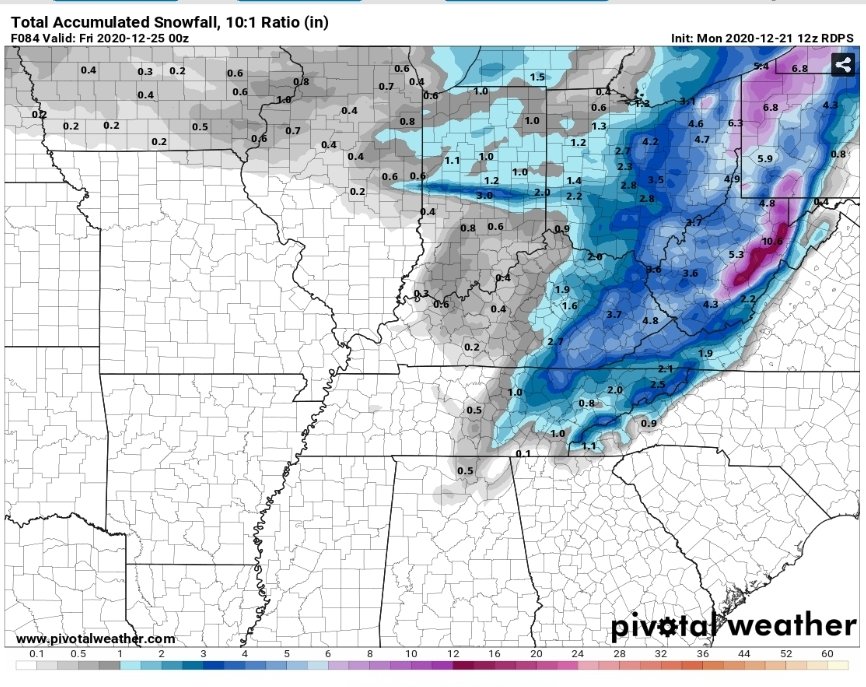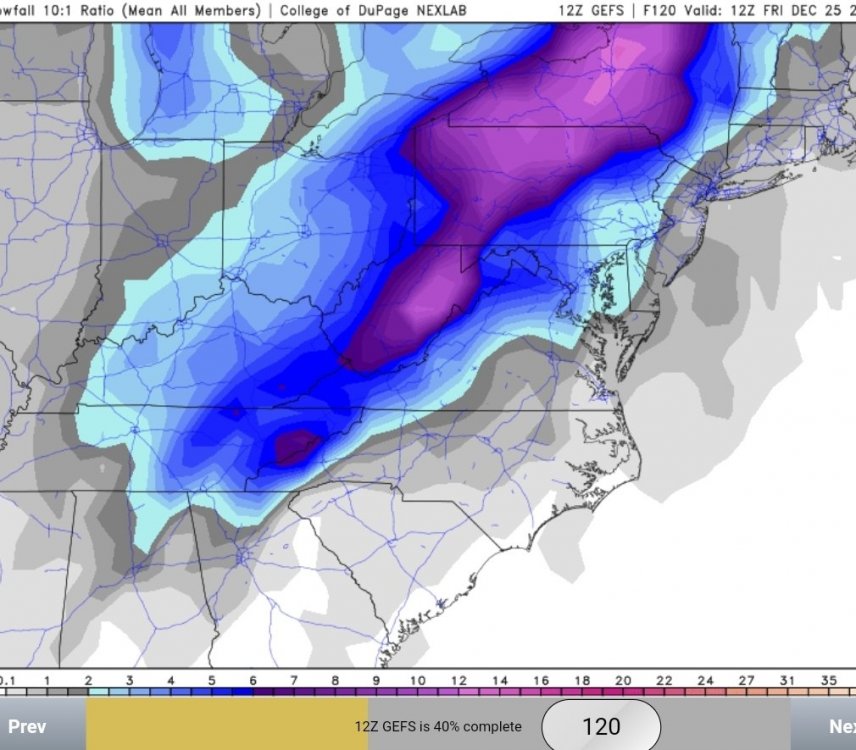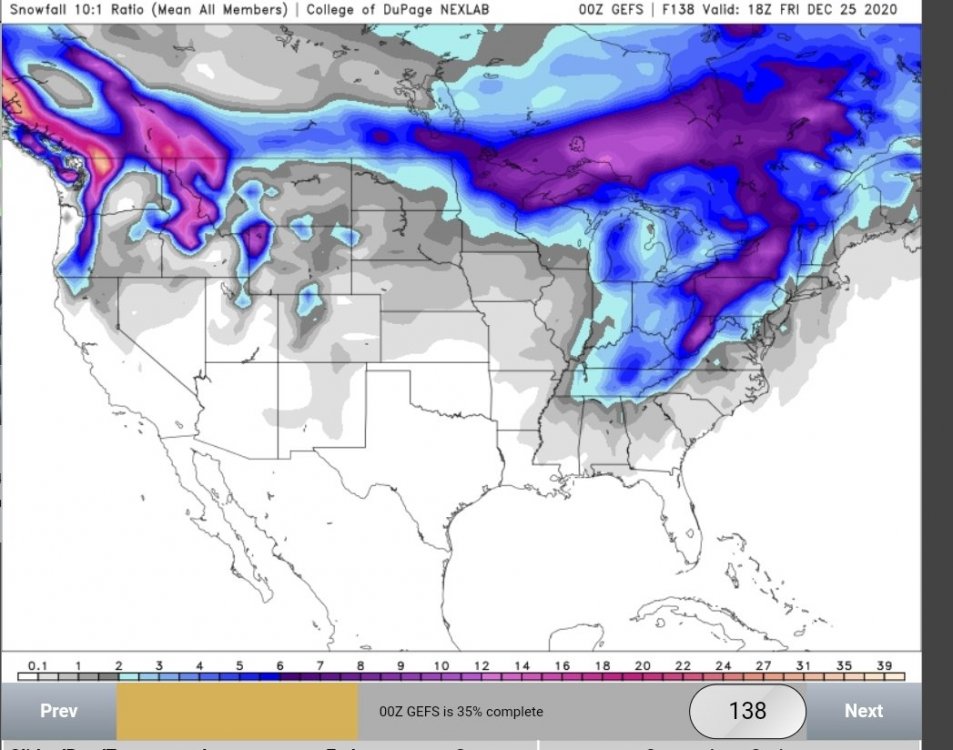
TellicoWx
Members-
Posts
2,307 -
Joined
-
Last visited
Content Type
Profiles
Blogs
Forums
American Weather
Media Demo
Store
Gallery
Everything posted by TellicoWx
-
Dandridge Dollop 12/24/20 Storm Thread (Winter Wonderland)
TellicoWx replied to AMZ8990's topic in Tennessee Valley
- 847 replies
-
- cold temperatures
- snow
- (and 8 more)
-
Dandridge Dollop 12/24/20 Storm Thread (Winter Wonderland)
TellicoWx replied to AMZ8990's topic in Tennessee Valley
Ratio'd map- 847 replies
-
- cold temperatures
- snow
- (and 8 more)
-
Dandridge Dollop 12/24/20 Storm Thread (Winter Wonderland)
TellicoWx replied to AMZ8990's topic in Tennessee Valley
12z GFS slower but pops the Lee low closer to NC/TN line- 847 replies
-
- cold temperatures
- snow
- (and 8 more)
-
Dandridge Dollop 12/24/20 Storm Thread (Winter Wonderland)
TellicoWx replied to AMZ8990's topic in Tennessee Valley
If you run the same loop at hour 6 on the Euro (tried it the past couple systems to see how it's doing), the hour 60-78 window it seems to work the "kinks" out..so I would agree we should have alot of answers (one way or the other by 0z tomorrow)- 847 replies
-
- 1
-

-
- cold temperatures
- snow
- (and 8 more)
-
Dandridge Dollop 12/24/20 Storm Thread (Winter Wonderland)
TellicoWx replied to AMZ8990's topic in Tennessee Valley
Something interesting to watch..go to hr 90 on the 0z GFS/Euro (Pivotal) at 500...and run a model trend. The GFS is far more consistent than the Euro (jumps all over the place every other run)...past was always other way around. Whatever upgrades was done to the Euro, I'm starting to wonder if it was a step backwards...was same during hurricane season. Either GEFs is just in another ballpark or the King has been dethroned lol- 847 replies
-
- 3
-

-

-
- cold temperatures
- snow
- (and 8 more)
-
Dandridge Dollop 12/24/20 Storm Thread (Winter Wonderland)
TellicoWx replied to AMZ8990's topic in Tennessee Valley
0z UKie has a similar piece that tries to dive in the backside...(stripe across AL)...starting to pickup up a potential phase maybe?- 847 replies
-
- 2
-

-
- cold temperatures
- snow
- (and 8 more)
-
Dandridge Dollop 12/24/20 Storm Thread (Winter Wonderland)
TellicoWx replied to AMZ8990's topic in Tennessee Valley
The one thing that is sticking out to me (and we have all seen it before)..is usually at some point even the GEFs loses a storm and brings it back (alot of wavering run to run)...it has been a really long time since I can remember the GEFs maintain a system this long (strengthening with each subsequent run this far out)- 847 replies
-
- 2
-

-
- cold temperatures
- snow
- (and 8 more)
-
Dandridge Dollop 12/24/20 Storm Thread (Winter Wonderland)
TellicoWx replied to AMZ8990's topic in Tennessee Valley
I think you will have no worries...southern valley possibly. The number of members now spitting out 2"+ amounts down into north central AL and NW GA has certainly got my attention lol- 847 replies
-
- 3
-

-
- cold temperatures
- snow
- (and 8 more)
-
Dandridge Dollop 12/24/20 Storm Thread (Winter Wonderland)
TellicoWx replied to AMZ8990's topic in Tennessee Valley
Yeah noticed the same on the GEFs...few members now going almost toward a more traditional Miller A- 847 replies
-
- 2
-

-
- cold temperatures
- snow
- (and 8 more)
-
Dandridge Dollop 12/24/20 Storm Thread (Winter Wonderland)
TellicoWx replied to AMZ8990's topic in Tennessee Valley
Generated the Lee side low slightly to far to the NE- 847 replies
-
- 1
-

-
- cold temperatures
- snow
- (and 8 more)
-
Dandridge Dollop 12/24/20 Storm Thread (Winter Wonderland)
TellicoWx replied to AMZ8990's topic in Tennessee Valley
Would like to see an ensemble of the CMC...OP was close to nailing the whole eastern valley- 847 replies
-
- cold temperatures
- snow
- (and 8 more)
-
Dandridge Dollop 12/24/20 Storm Thread (Winter Wonderland)
TellicoWx replied to AMZ8990's topic in Tennessee Valley
Almost all ensemble members are now onboard..0z GEFS- 847 replies
-
- 3
-

-
- cold temperatures
- snow
- (and 8 more)
-
December 2020 Medium/Long Term Pattern Discussion.
TellicoWx replied to John1122's topic in Tennessee Valley
Decent amount of GEFS members still picking up the Lee low and hammering the eastern valley -
December 2020 Medium/Long Term Pattern Discussion.
TellicoWx replied to John1122's topic in Tennessee Valley
Excellent write-up...the development of the Lee low will be on again/off again at this range (hard enough for models to get it right at close range). If you want a "surprise" snow (whether it's in the Rockies/Appalachians/Alps)...this is the setup. It was why the studies have been conducted so much in the Alps (unfortunately our mtns don't go that high, which is why it's more rare here)..due to LP forming in the Lee of the range even when zero vort maxes was depicted in modeling. -
December 2020 Medium/Long Term Pattern Discussion.
TellicoWx replied to John1122's topic in Tennessee Valley
The two camps have been fairly consistent the last couple days at H5...12z I think signaled which camp is caving (Euro towards the GFS). Both have a spoke of energy rounding the flow at 12z (GFS just had more of a surface reflection)...that spoke is gonna vary probably all the way until 24-36 hrs from the start. When/if Ops start losing that, then we will trouble. Euro wasn't a hair from the GFS solution. -
December 2020 Medium/Long Term Pattern Discussion.
TellicoWx replied to John1122's topic in Tennessee Valley
-
December 2020 Medium/Long Term Pattern Discussion.
TellicoWx replied to John1122's topic in Tennessee Valley
12z GFS still onboard -
December 2020 Medium/Long Term Pattern Discussion.
TellicoWx replied to John1122's topic in Tennessee Valley
I like where we are at currently, still a lot of boom or bust potential so to speak. Upside, at H5 most the modeling is holding the energy back to the sw compared to the more progressive GFS. Also, the depth and degree of the cold shown will lead to some high ratios (even with the GFS setup, atmos will squeeze out all the moisture it can). Downside, if the GFS is correct with it's more progressive solution (consolidating at the lakes vs a strong spoke of energy rotating thru and enhancing the Lee side), we end up with a light event...Regardless, it will be nice to see flakes on Christmas..we all know how rare that is. Next 24-36 hrs will be interesting to watch at H5. -
December 2020 Medium/Long Term Pattern Discussion.
TellicoWx replied to John1122's topic in Tennessee Valley
UKie/Euro OP now developing a lee side low similar to what the GFS had been doing. Several studies in the past couple decades have centered around mountain ranges assisting in low development...models tend to struggle somewhat when this occurs. Winds have to hit and ascend at just the right angle or you end up with a plain fropa. -
December 2020 Medium/Long Term Pattern Discussion.
TellicoWx replied to John1122's topic in Tennessee Valley
0z Euro -
December 2020 Medium/Long Term Pattern Discussion.
TellicoWx replied to John1122's topic in Tennessee Valley
0z UKie -
December 2020 Medium/Long Term Pattern Discussion.
TellicoWx replied to John1122's topic in Tennessee Valley
Individual members -
December 2020 Medium/Long Term Pattern Discussion.
TellicoWx replied to John1122's topic in Tennessee Valley
-
December 2020 Medium/Long Term Pattern Discussion.
TellicoWx replied to John1122's topic in Tennessee Valley
UKie/Euro/CMC (even with it's meandering run which gives the snow) are consolidating the energy along the southern end = cutter city...GFS is kinda on an island, but has taken steps toward the others (went from initial low up into Canada to winding up over the GL)...bias maybe, but "if" toward the tail then need it to keep digging to our south. -
December 2020 Medium/Long Term Pattern Discussion.
TellicoWx replied to John1122's topic in Tennessee Valley
Dr No strikes again lol



